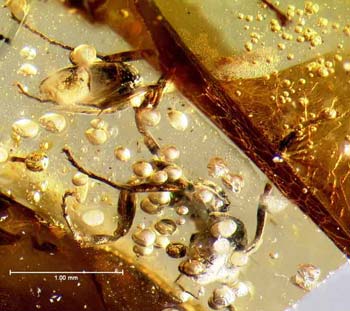 |
|
Fossilized ants trapped in amber (Image: LiveScience) |
The emergence of the first flowering plants 100 million years ago may have triggered a surge in ant species, scientists argue.
Today, there are about 11,800 known species of modern ants, which appear to have evolved from a single species millions of years ago. However, scientists previously knew very little about their evolutionary history.
A research team from Harvard University analyzed fossilized ants trapped in amber and discovered that the ancestors of modern ants scurried across the ground between 140 to 180 million years ago.
However, these ants diversified at a very slow rate until flowering plants, or angiosperms, began to sprout on this planet.
“A turning point occurred 100 million years ago, and ants began to diversify rapidly,” said Corrie Moreau, a co-author of the study. “This is also when we encounter the first angiosperm forests.”
These forests shed many leaves to the ground, creating numerous burrows and habitats suitable for specialized and diverse ant species. Today, the richest variety of species can still be found in plant litter and just below the surface soil. Forest canopies are also a favored home for ants, with some species even learning to glide back to their nests in the trees if they happen to fall.
Other insect species surged in population following the emergence of flowering plants. They also live under the leaf litter, providing a massive food source for ants. In turn, flowering plants became the preferred food for ants.
Today, ants make up about 15-20% of the animal biomass worldwide. Like scavengers, they help keep the earth clean by clearing away dead debris.
T. An


















































